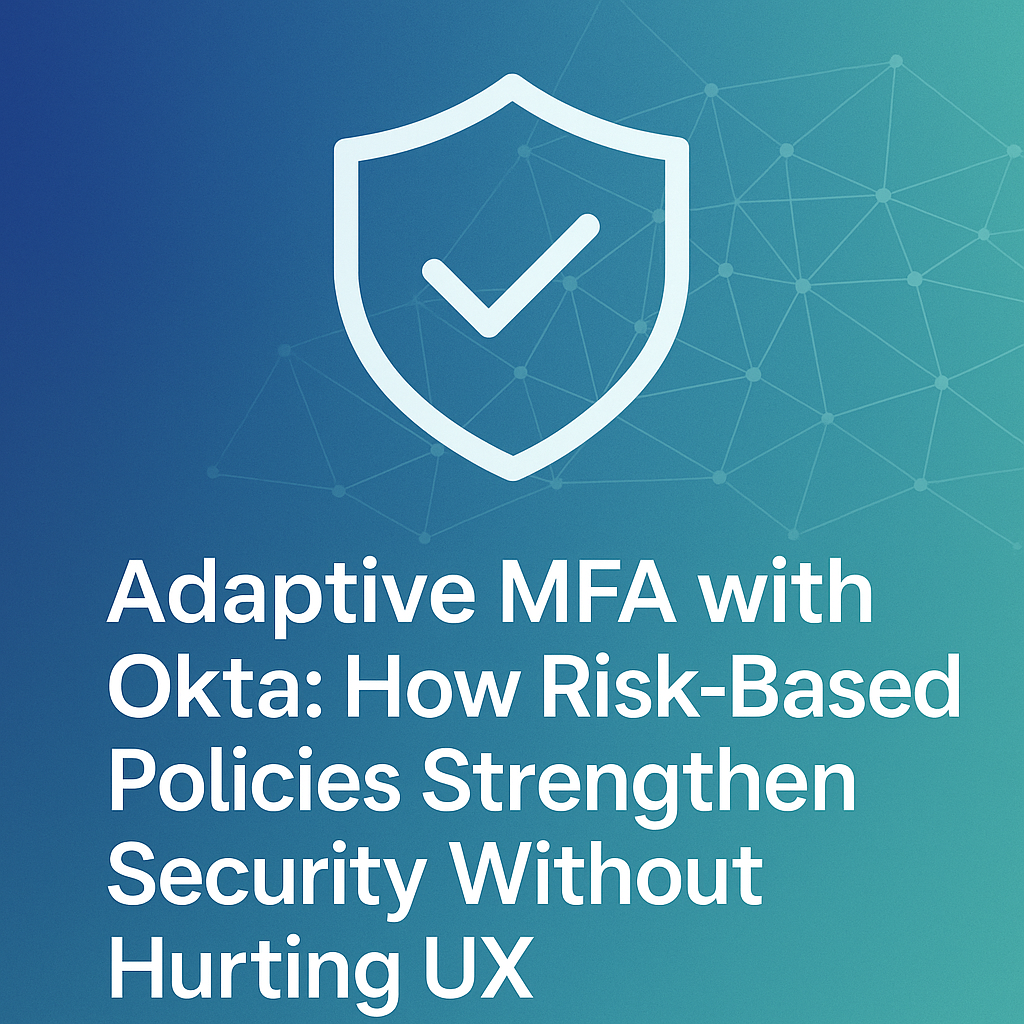Adaptive MFA with Okta: How Risk-Based Policies Strengthen Security Without Hurting UX
11/11/2025 • 4 min read • Provyra Solutions

Traditional MFA treats every login the same. Adaptive MFA treats every login smartly — factoring in device, location, and behavior to decide when to challenge and when to trust.
1. Why Adaptive MFA Matters
In a Zero Trust world, context is everything.
Static MFA policies create friction for users logging in from familiar devices and locations, while sometimes missing risky behavior that looks “normal.”
Okta Adaptive MFA leverages:
- 🔍 Device context (known, managed, or new)
- 🌍 Location intelligence (geo-velocity, IP reputation)
- 💡 User behavior (login time, patterns, anomalies)
- 🧠 Risk scoring (AI-based trust evaluation)
Instead of “always challenge,” Okta evaluates risk in real time — only prompting MFA when truly needed.
2. How It Works
At every sign-in attempt, Okta performs three key checks:
-
Device Context
Determines if the device is known, managed by MDM, or brand new. -
Network Context
Evaluates IP, ASN, and geo-location to detect anomalies like impossible travel or TOR networks. -
Behavioral Context
Tracks login patterns (time, device type, location) and assigns a risk level:- Low
- Medium
- High
The result: a dynamic authentication policy that adapts to the user’s situation — enhancing both security and usability.
3. Example Risk-Based Policy Flow
| Risk Level | Condition Example | Required Factors | |-------------|--------------------------------------------|-----------------------------------| | Low | Managed device, known IP | Password or Passkey only | | Medium | New device, new location | Password + Okta Verify (Push) | | High | Suspicious IP, TOR, or failed attempts | Password + Okta Verify + TOTP |
Okta can also block or step-up challenge users automatically based on thresholds.
4. Deployment Phases
Phase 1 — Foundation
- Enable Adaptive MFA in Okta Admin Console → Security → Multifactor → Adaptive
- Integrate with Okta Verify and WebAuthn factors.
- Test policy behavior in staging for different user personas.
Phase 2 — Controlled Rollout
- Assign adaptive policy to low-risk internal groups first.
- Use Okta System Logs to track MFA prompts vs. successful logins.
- Fine-tune policy actions (prompt, deny, allow) based on analytics.
Phase 3 — Full Deployment
- Expand coverage to contractors and third-party users.
- Use Risk Score API to integrate contextual signals from SIEM or CASB tools.
- Enforce “MFA only on risk” mode to reduce friction across the board.
5. Integration with Zero Trust
Adaptive MFA acts as the identity control plane in a Zero Trust model.
When integrated with device and network intelligence (like ZScaler, CrowdStrike, or MDM), you can:
- Allow logins only from compliant devices.
- Step-up challenges for unmanaged or risky devices.
- Deny access when risk exceeds a predefined threshold.
This alignment transforms MFA from a static gatekeeper into a dynamic trust broker.
6. Best Practices
- Start with internal employees. Roll out adaptive MFA to IT and Security teams first.
- Combine with Device Trust. Enforce MDM registration for low-friction approvals.
- Use granular policies. Apply risk-based logic per app or group.
- Monitor continuously. Use Okta System Log + ThreatInsight for anomalies.
- Educate users. Transparency builds trust in adaptive security decisions.
7. Measuring Success
Track measurable outcomes before and after implementing Adaptive MFA.
Quantifying results helps prove security ROI while validating the reduced user friction.
Interpretation
- 🎯 78% fewer MFA prompts means smoother user experience.
- ⚡ Login time down by 44% shows faster productivity.
- 🧩 Support load drop improves IT efficiency.
- 🛡️ Zero phishing incidents demonstrates tangible security gain.
8. Final Thoughts
Adaptive MFA isn’t about doing more — it’s about doing smarter.
By blending identity signals, device trust, and contextual analytics, Okta transforms authentication into a living, learning system.
When properly tuned, Adaptive MFA achieves both:
- Frictionless access for trusted users
- Instant defense against evolving threats
The future of IAM isn’t stricter logins — it’s smarter ones.